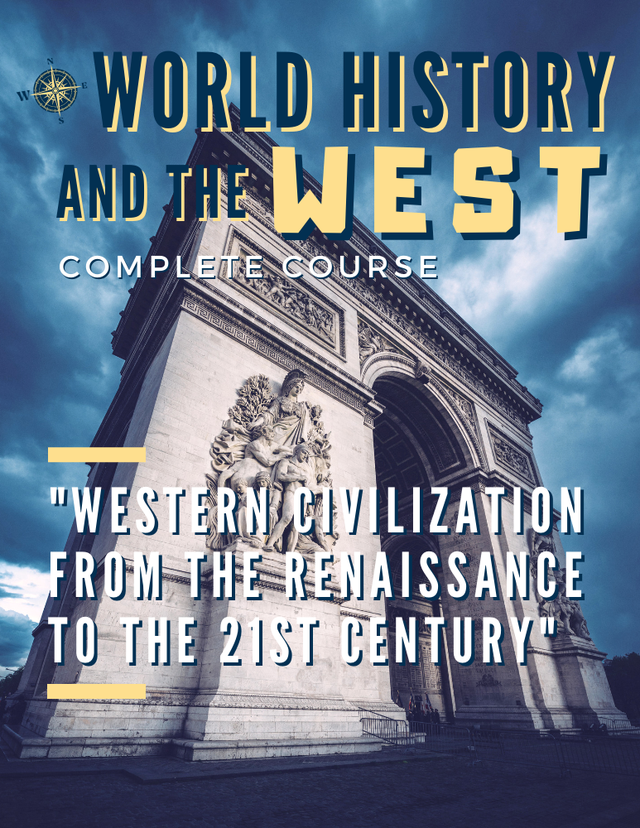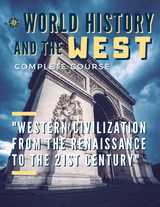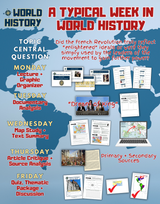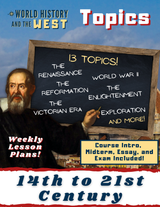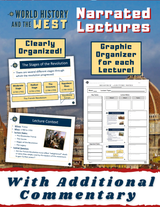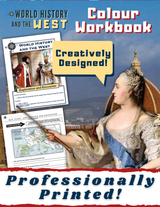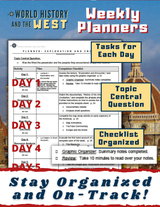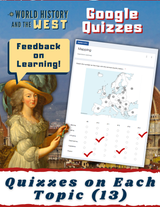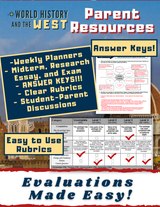- US History
- >
- Home School American History
- >
- World History and the West - Complete Course - Workbook and Digital Resources
World History and the West - Complete Course - Workbook and Digital Resources
SKU:
$125.00
$79.00
$79.00
On Sale
Unavailable
per item
It's finally here! "World History and the West: Western Civilization from the Renaissance to the 21st Century." Professionally printed workbook with access to digital resources are provided with each purchase!
What is the legacy of the West? Is it something to be reviled, celebrated, somberly remembered? History is complex and in every civilization, throughout history, the good and bad of humankind have been revealed. This course investigates and evaluates what events have contributed to the development of the West and the society that we live in today.
Through a Christian lens, students will seek to understand what has been God-honouring in the history of the West, and what has been dishounoring to God. This course highlights humankind's quest for freedom, innovation, and courage and also reveals humankind's ultimate need for a Saviour.
This course has been created by an experienced teacher to help students and their parents understand the development of the West from the Renaissance to the 21st century. In Ontario, this course is CHY4U, "The West and the World." In other provinces or states, this course will likely fit European History, World History, or Western Civilization course requirements. Check out the course summary and other course samples at the bottom of the page.
Location: Western Europe, the Americas, Africa, and Asia
Time Frame: 1350 to 2000s
Topics (13): Exploration and Encounter, The Renaissance, The Reformation, Establishment of European Empires, Absolutism and the Enlightenment, The French Revolution, The Napoleonic Era, Restoration and Revolution, The Victorian Era, The Great War, Inter-War Ideologies, World War Two, and the Changing Face of the West.
Philosophy:
History is much more than just facts and dates! This course includes a diverse range of activities intended to engage students and develop vital critical thinking skills. These resources are intended for gr. 11 or 12 students as a stepping stone to independent learning beyond high school. As a student progresses through a topic, the resources intentionally move from knowledge to application and critical thinking. In order to provide a focal point on what can be broad topics, the weekly resources are built around a central question which is introduced at the beginning of each topic and evaluated in-depth by students as they move through the resources.
In addition, an introductory unit focused on defining authentic Christianity, cultural Christianity, and political Christianity is provided. "Christianity and the West" is very broad and the division above is utilized throughout the course.
Workbook and Digital Resources:
A professionally printed workbook creatively designed and clearly organized is provided for the student. 250 pages.
Access to digital resources (eg. narrated lectures, answer keys, rubrics) is provided through Google Drive for easy access.
Weekly Topic Structure: (Samples at Bottom of Page)
Weekly Planner: Each week a highly organized planner is provided to guide you through a topic. Typically, a lecture is on "Day 1", followed by a documentary critique on Day 2, a map study on Day 3, article analysis, or artwork evaluation on Day 4, culminating with a critical thinking activity on Day 5.
Central Question: Each week the topic revolves around a central question (eg. Did the French Revolution truly reflect "Enlightened" ideals or were they simply used by the leaders of the movement to gain further power?) The resources and activities completed throughout the week will help students to evaluate the central question. This is the focal point of the week. Each central question also appears on the midterm and final exam! There is a very defined direction in the course.
Dynamic Lectures: Clearly organized narrated PowerPoint lectures, often interspersed with trivia questions to keep students engaged, are provided. Video clips are also incorporated. Creatively designed with visual appeal. Additional commentary is provided throughout the presentation beyond the notes on the slides.
Innovative Graphic Organizer: Not a regular student note-taking sheet! A lot of thought has been put into developing this graphic organizer to help students organize, synthesize, and, ultimately learn. The PowerPoint slides have already been added to the graphic organizer so that students can focus on making their own notes.
Documentary Critiques: Students watch a documentary about the topic of the week. Follow-along sheet provided.
Article Analysis': Students complete tasks based on an article reading: identifying the author's message, content questions, connections to the topic, prominent themes, vocabulary, and a deeper thinking question. This is often completed in small groups.
Map Studies: Students often view animated maps about the topic of the week and complete associated tasks. These are great for visual learners! A subscription to "the-map-as-history.com" is included with the purchase of the course!
YouTube Clip Analysis: There are many great channels devoted to creating engaging videos. Many are utilized throughout the course! Students are given analysis tasks while viewing each video.
Artwork Critiques: From time to time, students interpret different pieces of artwork. (eg. The Death of Marat)
Google Quiz: Students take an interactive quiz to assess their basic knowledge of the weekly topic. Each quiz is based on the topic lecture. Here is a sample from one quiz: free quiz here
Engaging Discussions: For every third topic, students discuss the central question of the week with a parent.
Thematic Package: The culmination of the week is to complete a critical thinking thematic package. The resources mentioned above prepare students to complete the activities in this package. These "deeper-thinking" activities include: identifying central and connecting issues, prominent values of the time, change and continuity, broader themes, and, finally, an in-depth analysis of the topic's central question.
(Samples at Bottom of Page)
Other Items:
Course Introduction Unit: A course overview, video critique, and article analysis are provided to help students understand the direction of the course.
ANSWER KEYS! Very clearly outlined keys to help you better evaluate student learning.
Clear Rubrics for Easy Marking: Rubrics for the thematic packages, discussions, video presentations, midterm, research, and exam are all provided.
What is the legacy of the West? Is it something to be reviled, celebrated, somberly remembered? History is complex and in every civilization, throughout history, the good and bad of humankind have been revealed. This course investigates and evaluates what events have contributed to the development of the West and the society that we live in today.
Through a Christian lens, students will seek to understand what has been God-honouring in the history of the West, and what has been dishounoring to God. This course highlights humankind's quest for freedom, innovation, and courage and also reveals humankind's ultimate need for a Saviour.
This course has been created by an experienced teacher to help students and their parents understand the development of the West from the Renaissance to the 21st century. In Ontario, this course is CHY4U, "The West and the World." In other provinces or states, this course will likely fit European History, World History, or Western Civilization course requirements. Check out the course summary and other course samples at the bottom of the page.
Location: Western Europe, the Americas, Africa, and Asia
Time Frame: 1350 to 2000s
Topics (13): Exploration and Encounter, The Renaissance, The Reformation, Establishment of European Empires, Absolutism and the Enlightenment, The French Revolution, The Napoleonic Era, Restoration and Revolution, The Victorian Era, The Great War, Inter-War Ideologies, World War Two, and the Changing Face of the West.
Philosophy:
History is much more than just facts and dates! This course includes a diverse range of activities intended to engage students and develop vital critical thinking skills. These resources are intended for gr. 11 or 12 students as a stepping stone to independent learning beyond high school. As a student progresses through a topic, the resources intentionally move from knowledge to application and critical thinking. In order to provide a focal point on what can be broad topics, the weekly resources are built around a central question which is introduced at the beginning of each topic and evaluated in-depth by students as they move through the resources.
In addition, an introductory unit focused on defining authentic Christianity, cultural Christianity, and political Christianity is provided. "Christianity and the West" is very broad and the division above is utilized throughout the course.
Workbook and Digital Resources:
A professionally printed workbook creatively designed and clearly organized is provided for the student. 250 pages.
Access to digital resources (eg. narrated lectures, answer keys, rubrics) is provided through Google Drive for easy access.
Weekly Topic Structure: (Samples at Bottom of Page)
Weekly Planner: Each week a highly organized planner is provided to guide you through a topic. Typically, a lecture is on "Day 1", followed by a documentary critique on Day 2, a map study on Day 3, article analysis, or artwork evaluation on Day 4, culminating with a critical thinking activity on Day 5.
Central Question: Each week the topic revolves around a central question (eg. Did the French Revolution truly reflect "Enlightened" ideals or were they simply used by the leaders of the movement to gain further power?) The resources and activities completed throughout the week will help students to evaluate the central question. This is the focal point of the week. Each central question also appears on the midterm and final exam! There is a very defined direction in the course.
Dynamic Lectures: Clearly organized narrated PowerPoint lectures, often interspersed with trivia questions to keep students engaged, are provided. Video clips are also incorporated. Creatively designed with visual appeal. Additional commentary is provided throughout the presentation beyond the notes on the slides.
Innovative Graphic Organizer: Not a regular student note-taking sheet! A lot of thought has been put into developing this graphic organizer to help students organize, synthesize, and, ultimately learn. The PowerPoint slides have already been added to the graphic organizer so that students can focus on making their own notes.
Documentary Critiques: Students watch a documentary about the topic of the week. Follow-along sheet provided.
Article Analysis': Students complete tasks based on an article reading: identifying the author's message, content questions, connections to the topic, prominent themes, vocabulary, and a deeper thinking question. This is often completed in small groups.
Map Studies: Students often view animated maps about the topic of the week and complete associated tasks. These are great for visual learners! A subscription to "the-map-as-history.com" is included with the purchase of the course!
YouTube Clip Analysis: There are many great channels devoted to creating engaging videos. Many are utilized throughout the course! Students are given analysis tasks while viewing each video.
Artwork Critiques: From time to time, students interpret different pieces of artwork. (eg. The Death of Marat)
Google Quiz: Students take an interactive quiz to assess their basic knowledge of the weekly topic. Each quiz is based on the topic lecture. Here is a sample from one quiz: free quiz here
Engaging Discussions: For every third topic, students discuss the central question of the week with a parent.
Thematic Package: The culmination of the week is to complete a critical thinking thematic package. The resources mentioned above prepare students to complete the activities in this package. These "deeper-thinking" activities include: identifying central and connecting issues, prominent values of the time, change and continuity, broader themes, and, finally, an in-depth analysis of the topic's central question.
(Samples at Bottom of Page)
Other Items:
Course Introduction Unit: A course overview, video critique, and article analysis are provided to help students understand the direction of the course.
ANSWER KEYS! Very clearly outlined keys to help you better evaluate student learning.
Clear Rubrics for Easy Marking: Rubrics for the thematic packages, discussions, video presentations, midterm, research, and exam are all provided.
|
|
|
| ||||||||||||||||||||||||
|
|
|
| ||||||||||||||||||||||||
